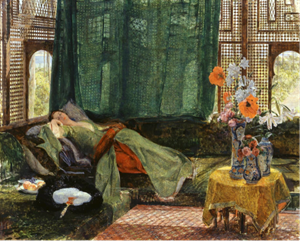
English orientalist painter John Frederick Lewis (1805-1876) developed a fascination with the Near East and took pains to represent the sights and the people he encountered in the region in an honest and positive light.
English orientalist painter John Frederick Lewis (1805-1876) developed a fascination with the Near East and took pains to represent the sights and the people he encountered in the region in an honest and positive light.
Lewis spent 10 years living in Cairo, during which time he was said to have taken to wearing local dress and to have lived in a traditional mansion, making efforts to blend in with local life. He arrived in the city in 1841, a time when self-proclaimed Ottoman Khedive, Muhammad Ali Pasha, was making efforts to welcome Europeans to the country as part of his modernisation program. Sadly, many European arrivals had misused their welcome, using it to rampage through Egypt’s temples and monuments, stealing sacred items, prizing reliefs from temple walls and looting for exotic treasures. There was a growing sense of imperialism amongst the European settlers, who were beginning to see the potential for a rich new empire. Indeed, shortly after Lewis left, a wave of British colonialists began to enter the country.
Lewis’ work was well received in London, where a growing appetite for Eastern images was taking hold. He seemed to have a fixation with Islamic architecture and furnishings and his images often included bright, vibrant colours and vivid details. His paintings were most often rendered in watercolour or oil and captured realistic scenes of Middle Eastern life.
At the time, many European artists in Egypt were creating salacious and titillating scenes of harems and exotic women, usually represented scantily dressed and in lascivious poses. Lewis’ paintings never featured a nude female. In fact, it is thought that he asked his wife to model in many of his works.
Several critics and art historians have praised Lewis’ work for its unbiased and honest presentation of Near Eastern life – a characteristic that made his work stand out amongst his peers whose representations of Egypt seemed to be heavily filtered through an imposing Western gaze.
Lewis’ Egypt was serene, happy and elegant, full of colour, flowers and dignity. In The Siesta (1876), completed during the final year of Lewis’ life, deep green drapes occupy the centre stage in the painting, obscuring the textured lattice behind them. The viewer is gazing into a spacious, open room, filled with light and air. The female subject of the image appears totally at ease and comfortable in her surroundings and is bathed in a gentle, soft green fabric.
The colour green bears a strong and resounding association with nature, new life and growth. It is the colour of the outdoors, of health and fertility, and yet here, we find it indoors, ushering the exterior in and bringing a feeling of freshness to the image.
Lewis’ choice of colour palette for this image is interesting. Whilst both rich and luscious, demonstrating the relative harmony and peace of the room in which it is set, it is also an unusual colour for Egypt. Luscious, deep green colours were much more closely associated with English society and ‘pastures green’. English men were proud of their rich natural landscapes, covered in lush grass and greenery. In fact, Victorian Britain was said to be ‘bathed in green’. The colour was undergoing something of a high fashion moment in the capital and it was a popular colour choice for both clothing and interiors at the time, but the dye was notoriously expensive and hard to procure.
In the early 1800’s, a public scandal had broken out when a batch of green dye secured by arsenic was linked to a wave of serious illness, blistered skin and even a handful of deaths. But the revelations about this toxic dye were not enough to deter the most ardent followers of fashion, many of whom continued to wear the fabrics, long after the dangers had been exposed.
The interiors of the room depicted in The Siesta reflect a wealth and a luxury that was much desired amongst English socialites. Despite English boasts of rich green fields and natural harmony, The Siesta shows a Near Eastern haven, where rich green colours are abundant, where nature’s enters into living spaces seamlessly and where beautiful women nap gently amongst opulent furnishings. Far from the lascivious images created by his contemporaries, Lewis’ Egypt is balanced, harmonious and at one with the natural world, as symbolised by the striking green interiors in this painting.
Interestingly, green has also come to have a second symbolic meaning, being associated with jealousy, greed and ambition. Could it be that Lewis was capturing something of the feelings of his Western viewers as they gazed at paintings of far off lands in beautiful, sunny climates, where gentle breezes blow through spacious, air-filled rooms while beautiful women take their afternoon rest.

ArtDependence Magazine is an international magazine covering all spheres of contemporary art, as well as modern and classical art.
ArtDependence features the latest art news, highlighting interviews with today’s most influential artists, galleries, curators, collectors, fair directors and individuals at the axis of the arts.
The magazine also covers series of articles and reviews on critical art events, new publications and other foremost happenings in the art world.
If you would like to submit events or editorial content to ArtDependence Magazine, please feel free to reach the magazine via the contact page.